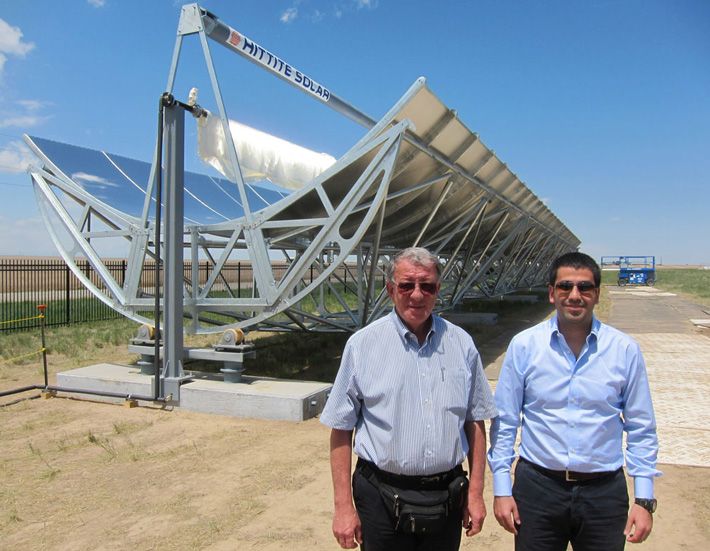
Photo: Hittite Solar Energy
HOT STUFF: Hittite's solar thermal technology focuses sunlight on tubes that turn water into superheated steam.
In the face of cheap photovoltaics, a Turkish start-up is relaunching solar thermal power
HITTITE SOLAR ENERGY
Company website:http://hittitesolarenergy.com
Year founded: 2006
Headquarters: Istanbul
Founders: Oğuz Çapan
Employees: 9
Funding raised: More than US $10 million
These are dark days for solar thermal power generation. Concentrating sunlight to produce steam that in turn drives a generator has lost its commercial shine amid a glut of cut-price solar panels. This glut has already famously upended Solyndra as well as other solar innovators, but a recently recapitalized Turkish start-up plans to put solar thermal back on track. Its strategy is to overhaul the steam production process and attack a market that photovoltaics can’t touch.
Istanbul-based Hittite Solar Energy was founded by Oğuz Çapan, its chairman and chief technology officer. Çapan sold a global oilfield-services company to join the renewable energy movement in 2005 and established Hittite Solar a year later. “My biggest advantage,” says Çapan, “is being an engineer and an outsider.”
Like most solar thermal power plants, Hittite Solar uses large, trough-shaped mirrors to focus sunlight onto steel tubes in glass jackets that maintain an insulating vacuum around the tubes. A fluid flowing through the tubes conveys heat to steam turbines, which are attached to generators. In other commercial plants this fluid is a synthetic oil, whose heat must be transferred to water to produce steam for the turbine. But in Hittite Solar’s setup the fluid is water, and the steam is made directly in the collector tubes.

Photo: Hittite Solar Energy
THE OUTSIDERS: CTO Oğuz Çapan (left) and CEO Serhan Süzer (right) are relative newcomers to the renewable energy industry
Producing steam directly delivers more power at lower cost; the heat exchangers used with oil-based collectors are not only pricey, they waste roughly 10 percent of the heat captured according to Çapan. Hittite Solar can also superheat its steam to 500 °C—the practical limit for the collector tubes—rather than a lower 400 °C limit for synthetic oils. Hotter steam further boosts the efficiency of the turbines by trimming heat losses another 5 percent.
Whereas conventional plants rotate both mirrors and collectors over the course of a day to track the sun, Hittite Solar pivots only the mirrors. This means flexible hoses are no longer required to connect the collector tubes. These hoses are the reason why thermal plants used synthetic oils: Flexible hoses are just too prone to leaking when used with high-pressure steam. But the static collectors allow for a much more robust system. “Everything is welded and flanged. This is a very simple solution,” says Çapan.
Çapan’s efforts might have come to naught without the marketing savvy and financial backing of Serhan Süzer, the scion of Turkey’s powerful Süzer Group. Süzer’s environmental concerns began in his college years when he joined Greenpeace Turkey. As CEO of the family’s Kentucky Fried Chicken and Pizza Hut franchises, Süzer won LEED certification for a KFC in Istanbul—a first for the chain globally—but struggled to effect deeper changes. So when Çapan’s original partner wanted out of renewable energy, Süzer recapitalized Hittite Solar and became its CEO in December 2011.
Hittite Solar has demonstrated its technology in four pilot plants of increasing scale, growing from 30 kilowatts of heat output to 200 kW. The company also set up a demo plant in Colorado in 2012 and says it is negotiating to install a 2-megawatt power plant in Qatar.
To help compete with cheap photovoltaics, Çapan and Süzer hope to enter an additional market unique to solar thermal technology. Turkey’s fast-growing industrial sector is building new paper mills, textile, and food-processing plants, and exploring heavy oil production. These facilities all require steam, which Hittite estimates can be generated by next-door solar thermal plants at a cost that’s 50 to 60 percent lower than by burning expensive natural gas. Süzer estimates that Turkey currently imports natural gas from Russia at roughly US $14 per thousand cubic feet for a 1- to 2-year contract—nearly seven times the cost of gas in the United States.
When IEEE Spectrum visited Hittite Solar in Istanbul last November, Çapan and Süzer were prepping a final demonstration plant near Izmir, to begin operating by the end of 2012 at 50-kW capacity and then scale up to 1 MW. The plant, to be equipped with thermal storage to enable 24-hour operation, is intended to convince conservative industrialists that Hittite Solar’s equipment is ready to rumble. “Businessmen like to see that steam roaring into the atmosphere,” says Çapan. His partner, the businessman, agrees. “They have a pragmatic approach,” says Süzer. “Their brain is in their eyes.”
About the Author
Peter Fairley is an IEEE Spectrum contributing editor based in Victoria, B.C., Canada, and Paris. He explores the technological and economic issues of energy. In November, he reported on San Francisco’s secret DC grid.
You have read this article Green Energy /
Solar Energy
with the title Hittite's solar thermal technology focuses sunlight on tubes. You can bookmark this page URL http://emill-emil.blogspot.com/2012/12/hittite-solar-thermal-technology.html. Thanks!







